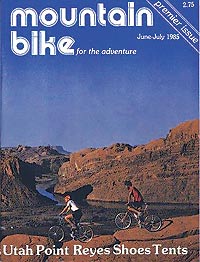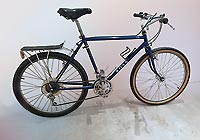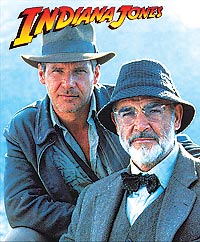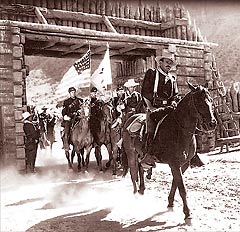 |
| The inaugural issue of Mountain Bike Magazine featured a cover photo of the Moab Valley from Slickrock trail, and today riders from all over the world descend on Moab to enjoy the scenery from the seat of their bike. |
Despite the handful of early tour companies, tourism in Moab did not start flourishing until the late 1980’s. With the mining boom fading into bust after the Atlas Mill shut down operations in 1984, many Moabites simply packed up and moved away. Those that stayed sought alternative ways to make ends meet, such as the Groff brothers who opened Moab’s first bike shop, Rim Cyclery, in 1983. According to their website, “at the time, mountain biking was… something a very small [number] of people did.” That began to change after one of those early mountain bikers, Hank Barlow, used pictures of Rim Cyclery bikers on Slick Rock Trail as the feature for the premier issue of Mountain Bike Magazine, the first full-color biking magazine of its kind. The issue was released in summer 1985, putting Moab on the map as a prime destination for mountain bikers.
Despite the promising beginnings of Moab mountain biking, the loss of the mining industry created a big economic hole to fill. By 1986 there were over 250 vacant houses in town, many businesses were boarded up, and two-thirds of the workforce was collecting unemployment. Grand County’s legacy of ghost towns made Moabites worry that Moab was on the same course. An open house community meeting at Star Hall brought in over 300 people to discuss what could be done. The majority were focused on how to convert the vacant land back to orchards and farms, until one man in the back spoke up. He suggested that Moab needed think outside the box. Joe Kingsley, the then president of the Chamber of Commerce, recalls the man saying, “Look at what you have here! This is a beautiful place! It is a gem in Utah, and in the United States. Even your dump is scenic!”
 |
| There’s a saying that Marin County (CA) provided the “tools,” Crested Butte (CO) provided the “spirit,” and Moab provided the “place.” In 1983 Rim Cyclery, Moab’s first bike shop, was selling road bikes and outdoor gear when a customer from California arrived with a precursor to today’s mountain bike – a modified 5-speed Ross. 1984 Ross Mount Rainier is on loan from Eric Jones. |
Everybody laughed, but the Moab Chamber of Commerce took the idea and ran with it. They launched the World’s Most Scenic Dump Contest, calling for submissions from cities and towns all over the world to find the prettiest, most scenic dump. Many major networks covered the contest and submissions poured in from over 100 cities across the globe. In the end, the contest was tied between Moab and Kodiak, Alaska. From then on, tourists began to flock to Moab in ever-increasing numbers. Today, Moab sees over three million visitors annually from all over the world, making it one of the most successful tourist destination towns in the nation. History has proven that Moab is nothing if not resilient. From boom to bust to boom, this community never lost its sense of optimism. And no matter what challenges lay ahead, our persistence and ingenuity will see us through.
Sources include the Times Independent, Moab Sun News, National Park Service and Utah State Parks, Rim Cyclery, Marin Museum of Bicycling, and the Moab Museum’s oral history collection.
Support Moab Museum as it brings more objects and oral histories to life. Visit moabmuseum.org to explore the exhibits while we are physically closed and become a member today.
Moab Museum
Downtown Moab, 118 East Center Street
moabmuseum.org • 435-259-7985
 Red Cliffs Lodge, on the banks of the mighty Colorado River, is home to the Moab Museum of Film & Western Heritage. The lodge is built on the old George White Ranch, a key location for nine of the big westerns including Rio Grande, Cheyenne Autumn, Ten Who Dared, The Commancheros, and Rio Conchos.
Red Cliffs Lodge, on the banks of the mighty Colorado River, is home to the Moab Museum of Film & Western Heritage. The lodge is built on the old George White Ranch, a key location for nine of the big westerns including Rio Grande, Cheyenne Autumn, Ten Who Dared, The Commancheros, and Rio Conchos.
The late George White was founder of the Moab to Monument Valley Film Commission, the longest ongoing film commission in the world.
In the museum one can learn more about film locations, how the sets are built, and how the filming process is managed on nature’s own sound stage. On display in the museum are production photographs, movie posters, autographed scripts, props from the many pictures filmed in the area, and displays about the western ranching heritage. For information, call Red Cliffs Lodge at 435-259-2002.
 Through the magnificent landscapes of southeastern Utah, writers have been inspired and stories born here. Zane Grey, the famous western novelist, traveled through the area in 1912. His visit inspired him to write his book Riders of the Purple Sage. The book was made into a movie starring Ed Harris and Amy Madigan, and filmed on locations around Moab.
Through the magnificent landscapes of southeastern Utah, writers have been inspired and stories born here. Zane Grey, the famous western novelist, traveled through the area in 1912. His visit inspired him to write his book Riders of the Purple Sage. The book was made into a movie starring Ed Harris and Amy Madigan, and filmed on locations around Moab.
| A partial list of stars that have made movies in Moab John Wayne, Maureen O'Hara, Henry Fonda, Lee Marvin, Rock Hudson, Jimmy Stewart, Richard Boone, Anthony Quinn, Mickey Rooney, Shirley Temple, Kris Kristofferson, Billy Crystal, Robert Duvall, Gene Hackman, Bill Murray, Jack Palance, Susan Sarandon, Geena Davis, Ted Danson, Tom Cruise, and many more. |